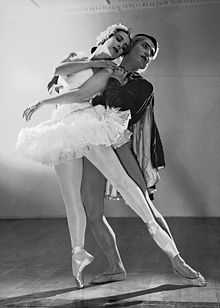Ballet dancer

A ballet dancer (Italian: ballerina fem., ballerino masc.) is a person who practices the art of ballet.
Gendered titles
Traditional, gender-specific titles are used for ballet dancers. In French, a male ballet dancer is referred to as a danseur and a female as a danseuse. In Italian, a ballerina is a female who typically holds a principal title within a ballet company; the title for equally ranked males is ballerino. In Italian, the common term for a male dancer is danzatore and a female dancer is a danzatrice.
These terms are rarely used in English. Since ballerino is not used in English, it does not enjoy the same connotation as ballerina. A regular male dancer in Italy is called a danzatore, while ballerino usually denotes a male ballet dancer in Italy. In the English speaking world, boys or men who dance classical ballet are usually referred to as (male) ballet dancers. Often "ballerino" is used in English-based countries as slang.
As late as the 1950s a ballerina was the principal female dancer of a ballet company who was also very accomplished in the international world of ballet, especially beyond her own company; female dancers who danced ballet were then called danseuses or simply ballet dancers. Ballerina was a critical accolade bestowed on relatively few female dancers, somewhat similar to the title diva in opera. The male version of this term is danseur noble (French). Since the 1960s, however, the term has lost this honorific aspect and is applied generally to women who are ballet dancers.[1]
In the original Italian, the terms ballerino (a male dancer, usually in ballet) and ballerina do NOT imply the accomplished and critically acclaimed dancers once meant by the terms ballerina and danseur noble when used in English. Rather, they simply mean one who dances ballet. Italian terms that do convey an accomplished female ballet dancer are prima ballerina and prima ballerina assoluta (the French word étoile is used in this sense at the Scala ballet company in Milan but has a different meaning at the Paris Opera Ballet.) Danzatore (male) and danzatrice (female) are general terms in Italian to signifiy dancers.
The term ballerina is sometimes used to denote a well-trained and highly accomplished female classical ballet dancer. In such cases, it is a critical accolade that signifies exceptional talent and accomplishment.
Hierarchic titles
Many use the term ballerina incorrectly, often using it to describe any female ballet student or dancer. Ballerina was once a rank given only to the most exceptional female soloists. In opera, the informal equivalent is diva, which means a distinguished singer, but may also denote a prima donna (i.e. a temperamental person; a person who takes adulation and privileged treatment as a right and reacts with petulance to criticism or inconvenience). In similar fashion, and mostly informally, the ballerina would be the prima donna of the dance world.
Women
More or less, depending on the source, the rankings for women, from highest to lowest, used to be:
- Prima ballerina assoluta( Italy)
- Prima ballerina, premier sujet or première danseuse
- Sujet
- Coryphée
- Corps de ballet
Men
For men, the ranks were:
- Premier danseur noble
- Premier danseur
- Danseur
- Sujet
- Coryphée
- Corps de ballet
- Ballerino
Today
Ballet companies continue to rank their dancers in hierarchical fashion, although most have adopted a sex neutral classification system, and very few recognise a single leading dancer above all other company members. In most large companies, there are usually several leading dancers of each sex, titled principal dancer or étoile to reflect their seniority, and more often, their status within the company. The most common rankings (in English) are:
- Principal Dancer
- Soloist (or First Soloist)
- Demi-Soloist (or Second Soloist)
- Corps de Ballet
- Apprentice
The title of prima ballerina assoluta is rarely used, and it is usually reserved as a mark of respect for an internationally renowned dancer who has had a highly notable career.
Dancers who are identified as a guest artist, are usually those who have achieved a high rank with their home company, and have subsequently been engaged to dance with other ballet companies around the world, normally performing the lead role. They are usually principal dancers or soloists with their home company, but given the title of Guest Artist when performing with another company.
Prima ballerina assoluta
The title or rank of prima ballerina assoluta was originally inspired by the Italian ballet masters of the early Romantic Ballet and was bestowed on a ballerina who was considered to be exceptionally talented, above the standard of other leading ballerinas. The title is very rarely used today and recent uses have typically been symbolic, in recognition of a notable career and as a result, it is commonly viewed as an honour rather than an active rank.
See also
References
- ↑ Edwin Denby (1965). Dancers, Buildings, and People in the Streets
External links
![]() Media related to Ballet dancers at Wikimedia Commons
Media related to Ballet dancers at Wikimedia Commons
| ||||||||||||||||||||||||||||||||||||
